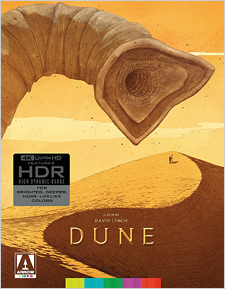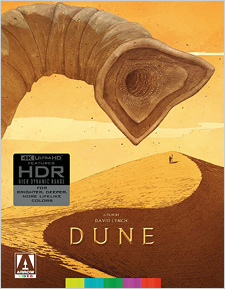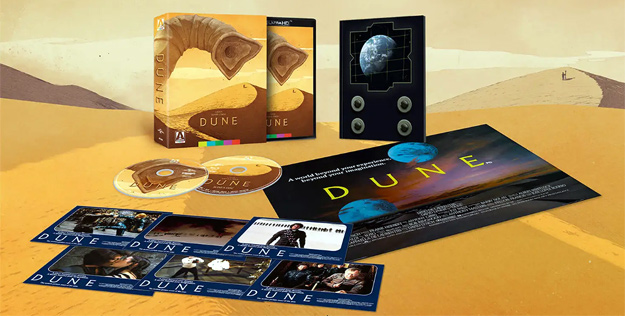Dune (1984): Limited Edition (4K UHD Review)

Director
David LynchRelease Date(s)
1984 (August 31, 2021)Studio(s)
Dino De Laurentiis Corporation/Universal Pictures (Arrow Video)- Film/Program Grade: C-
- Video Grade: A
- Audio Grade: A
- Extras Grade: B
Review
In the history of science fiction, there have been a number of high-concept works that cut through the trappings of pulp “sci-fi” (robots, laser guns, aliens) to describe timeless stories of the human condition. Among the best are Arthur C. Clarke’s 2001: A Space Odyssey, Isaac Asimov’s Foundation Trilogy, and Ray Bradbury’s The Martian Chronicles. As good as any of them, however, is Frank Herbert’s Dune. Set many thousands of years in the future, it’s a multi-layered tale of two great royal houses engaged in a struggle to control the most valuable planet in the universe... Dune (also known as Arrakis), and its all-important export, the spice melange that makes space travel, longer life, and prescience possible. The rightful heir to the planet, young Paul Atreides, is the product of an ancient genetic breeding program. His is more than a political struggle though; before the story is fully told, Paul will become Muad’Dib—a prophet who will help the native people of Arrakis to reclaim their world... and help the human race to reclaim its identity. Richly steeped in political, cultural, and ecological detail, with no small measure of commentary on religion, gender dynamics, and colonialism, Dune deservingly won both the Hugo and Nebula awards for science fiction literature and remains one of the most highly-regarded novels of all time.
For years, filmmakers struggled to bring Herbert’s work to the big screen, with Alejandro Jodorowsky and Ridley Scott each mounting failed attempts. Finally, in 1984, director David Lynch—fresh from the success of The Elephant Man—delivered his vision to the screen with decidedly mixed results. For fans of the novel, the Lynch film plays out like a relentlessly dull CliffsNotes version of a Dune comic book, alternating between slow-paced exposition and scenes of characters thinking, repeating the dialogue of others in their minds, and talking or dreaming about future events and plans. When things actually do happen, they’re strangely melodramatic, at times operatic, and occasionally downright grotesque, with frequently wonky visual effects work (the rubber sandworms are especially bad). But in order to jam as much of the story into the film’s 137 minutes as possible, important concepts in the novel were altered or omitted entirely. The result was a critical and box office bomb, which Lynch eventually disavowed, claiming that his work was inhibited by meddling from producers Dino and Raffaella De Laurentiis. (Notably, the director wasn’t allowed the right of final cut.) An extended, 190-minute “TV version” of the film was later created, but Lynch hated this so much that he asked to have his name removed from it (so the infamous “Alan Smithee” is credited instead). Nevertheless, in any version, Lynch’s Dune is just not a good film.
Yet to this day, it has many fans and it’s not difficult to appreciate why. The ensemble cast here is extraordinary, with earnest performances by the likes of Kyle MacLachlan, Jürgen Prochnow, Francesca Annis, Virginia Madsen, Patrick Stewart, Max von Sydow, Kenneth McMillan, Sean Young, Sting, José Ferrer, Linda Hunt, Dean Stockwell, and Freddie Jones to name but a few. The cinematography is by two-time Academy Award winner Freddie Francis (The Elephant Man, Glory). And it’s hard not to be impressed by the way that Lynch walks right up to the line of kitsch and camp—a line that Mike Hodges’ Flash Gordon leaps gleefully—but never crosses it. He does this by handling the film’s subject matter with a grave seriousness, and by showcasing his world-building through carefully arranged and highly-stylized mise-en-scène that seems to use the work of artists H.R. Giger, Rob Cobb, and Moebius (all of whom collaborated on Jodorowsky’s earlier attempt) as a starting point, even as production designer Anthony Masters (2001: A Space Odyssey) takes it all in a new direction (with the help of creature designer Carlo Rambaldi and others). And then there’s the film’s symphonic prog-rock soundtrack, composed by the band Toto (yes, “the rains down in Africa” Toto), with an assist by Brian Eno (ex-Roxy Music), Roger Eno, Daniel Lanois, and the Vienna Symphony Orchestra. While not as catchy as Queen’s soundtrack for Flash Gordon, the score is an evocative and moody gem that’s majestic in its own right.
Dune was shot on 35 mm photochemical film using Arriflex 35 BL2 and Photo-Sonics 4E cameras with Todd-AO anamorphic lenses. Visual effects photography was completed using the VistaVision process, and the film was finished photochemically at the 2.35:1 aspect ratio for wide theatrical release (with 70 mm “blow up” prints framed at 2.20:1). For this Ultra HD, Arrow has licensed a new 4K scan and restoration of the film commissioned by Koch Films in Germany, a process that included new grading for both SDR and HDR (both Dolby Vision and HDR10 are included here). It should be note that this release includes only the 137-minute theatrical cut of the film. (Arrow wanted to include the “Alan Smithee” Extended Edition as well, but Universal disallowed it.) In any case, this new remaster is gorgeous, with a notable increase of resolution over the previous Blu-ray editions. Save for optically-composited titles and the odd shot with soft focus, image detail is remarkable here. Grain is pleasing, organic, and crisply-defined. For any other film, the remastering team might have been tempted to dial the grain back a little bit, but by choosing not to, every bit of fine detail that’s visible in the negative has been preserved. That’s critical, because Dune is a film that’s rife with texturing on almost every set piece, costume, model, and prop, from the subtle veining of marble tiles, to the voluminous gold leaf in the Emperor’s throne room and Guild Heighliner docking bays, and even the fine dust and sand blowing in the wind in establishing shots of Arrakis. Witness the sequence of shots as the Atreides frigates land in Arrakeen—your eyes can barely stay still for scanning all of the visible detail! The film’s color palette is more vibrant and nuanced here than ever before, thanks to the wider gamut of HDR (Dolby Vision has the edge, but HDR10 is lovely too). Metallic golds and silvers exhibit a bright, realistic sheen. Woods and leathers are richly saturated. Skin tones are accurate. Baron Harkonnen’s diseased flesh has never looked more sickly. Shadows are ink-black in interior locations. This is very close to a reference-grade image.
Arrow’s 4K disc includes primary audio in English 5.1 DTS-HD Master Audio format (preserving the 6-track 70 mm sound experience), as well as English 2.0 DTS-HD MA (replicating the wide theatrical release’s stereo experience). The surround mix dazzles with a big wide soundstage, abundant bass, smooth and natural panning in the surrounds, and impressive dynamic range. Atmospherics are almost constant, creating a true hemispheric sonic experience, filled with subtle environmental cues (among them wind, blowing sand, and Lynch’s constant ominous droning and machine noises), inventive foley, and bombastic explosions and laser blasts during the battle scenes. Dialogue is clean and clear, and Toto’s score is staged in the mix with excellent fidelity. Overall, the sound experience here is very well matched to the visuals. Optional English SDH subtitles are also included.
Arrow’s Ultra HD release is a 2-disc set. It includes the film itself in native 4K along with the following special features on the actual UHD disc:
- Audio Commentary by Paul M. Sammon
- Audio Commentary by Mike White
- Impressions of Dune (SD – 39:39)
- Designing Dune (SD – 8:55)
- Dune FX (SD – 6:01)
- Dune Models & Miniatures (SD – 7:03)
- Dune Costumes (SD – 4:50)
- Deleted Scenes with Introduction by Raffaella De Laurentiis (SD – 11 scenes – 17:13 in all)
- Destination Dune (SD – 6:25)
- Trailer #1 (HD – 3:09)
- Trailer #2 (HD – 1:31)
- US TV Spots (SD – 3 in all – 1:37)
- VHS Promo (SD – :37)
- Image Gallery: Production Stills (HD – 336 in all)
- Image Gallery: Behind the Scenes (HD – 86 in all)
- Image Gallery: Cast Portraits (HD – 262 in all)
- Image Gallery: Production Design (HD – 205 in all)
- Image Gallery: Poster & Video Art (HD – 50 in all)
Impressions of Dune, Destination Dune, and the first theatrical trailer are all carried over from the 2003 Sanctuary Visual Entertainment DVD release in the UK DVD, whereas Designing Dune, Dune FX, Dune Models & Miniatures, Dune Costumes, and the Deleted Scenes with Introduction by Raffaella De Laurentiis are retained from Universal’s Extended Edition DVD release in 2005. Most of this content was originally produced in SD and has been upsampled here to HD. (Both trailers are now in full native HD, newly-scanned from film.) The featurettes are surprisingly good content-wise, if not particularly comprehensive.
The rest of the extras on the 4K disc are brand new, including separate audio commentaries with author and film historian Paul M. Sammon and Mike White of The Projection Booth podcast. Sammon was actually involved in the production of this film for two years as a documentarian, so his track is essentially a free-flowing recollection of that experience. White’s track, on the other hand, is a more traditional commentary, offering trivia and historical details on the making of the film. Both are quite good, though Sammon’s is the more engaging listening experience simply for his unique and first-hand perspective. There’s also a host of TV spots and even a promo for the 1985 MCA Video VHS release. (Some of these were actually provided to Arrow by our own Tim Salmons.) And the new galleries here are extraordinarily extensive, featuring nearly 1K images in total, all in full HD.
Moving on, the package also includes a Blu-ray Disc with the following additional special features:
- Beyond Imagination: Merchandising Dune (HD – 22:37)
- Prophecy Fulfilled: Scoring Dune (HD – 24:52)
- Additional Interviews: Another World: Giannetto de Rossi (HD – 17:20)
- Additional Interviews: Golda Offenheim (SD – 26:16)
- Additional Interviews: Paul Smith (SD – 8:50)
- Additional Interviews: Christopher Tucker (HD – 3:02)
These too are all new, produced by Daniel Griffith’s Ballyhoo Motion Pictures. Beyond Imagination features Brian Stillman (The Toys That Made Us) talking about the many toys and other perplexing tie-in products created to market Lynch’s Dune—which was not exactly a kids film. The featurette is quite good, and honestly there are more items discussed and shown here than most of you likely remember from the time. Better still is Prophecy Fulfilled, which includes new interviews with members of Toto (Steve Lukather and Steve Porcaro) and music historian Tim Greiving on the creation of film’s score and the context behind it. You even get to hear a demo version of the film’s Main Theme. Then there are a host of additional interviews, including a new one with make-up artist Giannetto de Rossi, and archival chats with production coordinator Golda Offenheim, actor Paul Smith, and make-up artist Christopher Tucker.
So at this point, you might be wondering: What’s missing? Well, there’s a brief BBC Interview with Frank Herbert (SD – 1:24) missing from the Sanctuary Visual Entertainment DVD. (In fact, there’s a disappointing lack of any content with Herbert himself.) And of course, there’s the aforementioned Extended Edition version of the film, also know as the “Alan Smithee” TV Cut. This was included on the 2005 Universal DVD release in SD, but it’s since been pulled out of availability here in the States by the studio. So while Arrow tried to include it here, they were not allowed to do so. What makes this particularly frustrating, is the fact that Koch Films in Germany is being allowed to include it in remastered HD on their own forthcoming Dune: Der Wüstenplaneten – 7-Disc Ultimate Edition, which—unfortunately—is only available from Koch via their online web store (which does not ship to North America, and the Blu-rays in this set are also Region B-locked).
This brings us to the elephant in the room that must now be addressed: Arrow’s 4K and Blu-ray release was originally announced to include a new feature-length documentary by Ballyhoo Motion Pictures entitled The Sleeper Must Awaken: Making Dune. Subsequently, Arrow announced that “due production issues beyond [their] control” the documentary was being dropped from the release. Griffith then revealed on social media that he needed a few additional weeks to complete it. Obviously, Arrow was unwilling or unable to wait (perhaps due to tight replication schedules). Whatever the reason for it, its omission here is deeply disappointing. There has never been a truly comprehensive documentary on the making of Dune, and the film certainly deserves one. This omission is doubly disappointing because—once again—all versions of the Koch 4K and Blu-ray sets (now due for release in Germany in October) will include this documentary. The wide release versions of the Koch set are now available for pre-order on Amazon.de (see here and here) which does at least ship to North America. (Again, however, the Blu-rays in these sets will be Region B-locked.) In any case, judging by the number of frustrated emails and private messages we’ve been getting from readers here at The Digital Bits, Dune fans are… to put it mildly… displeased by all this.
Still, Arrow’s 4K and Blu-ray editions do include some nice additional items in the packaging, which itself features lovely new artwork by Dániel Taylor. There’s a double-sided foldout poster with the Tylor art on one side and the original poster art on the other. There’s a set of 6 postcard-sized lobby card reproductions. And you get a lovely 60-page softcover book of liner notes and essays by Andrew Nette, Christian McCrea, and Charlie Brigden. This book also includes a reproduction of a 1984 American Cinematographer interview by Ric Gentry with sound designer Alan Splet, excerpts from a Chris Rodley interview with Lynch (from his book Lynch on Lynch), and a glossary of Dune terminology given to audience members in select theaters at the time of the film’s original release.
All in all, this is a solid batch of material and the new content is quite good. Clearly, Arrow’s intention with this release was to create a truly comprehensive special edition for Lynch’s Dune. So if they’ve fallen somewhat short of that mark, one must still at least admire the effort and appreciate what is actually included here.
It should be noted at this point that Arrow has issued a separate version of this 2-disc set that swaps out the 4K movie disc for a remastered Blu-ray version of the movie (click here for that on Amazon). They also have a 3-disc Steelbook SKU that includes both the 4K and Blu-ray movie discs, along with the Blu-ray bonus disc (click here for that). What’s more, the online retailer Zavvi (which owns Arrow Video) also had a 3-disc Limited Edition Steelbook package that added a 100-page book called The Design of Dune (but unfortunately, that version sold out several weeks ago—click here if you’d care to see it anyway).
As an adaptation of Frank Herbert’s landmark science fiction novel, David Lynch’s Dune is an utter failure. And yet it’s a glorious failure that simply cannot be dismissed. With the perspective of years, this Dune has certainly grown in appreciation to become a kind of cult classic, and one that’s long deserved better treatment on home video. Arrow Video’s new 4K Ultra HD release isn’t quite the ultimate edition that fans may have been hoping for, but its remastered presentation represents a quantum leap beyond all previous releases on disc. It’s therefore easy to recommend for most fans of Dune.
- Bill Hunt
(You can follow Bill on social media at these links: Twitter and Facebook)


